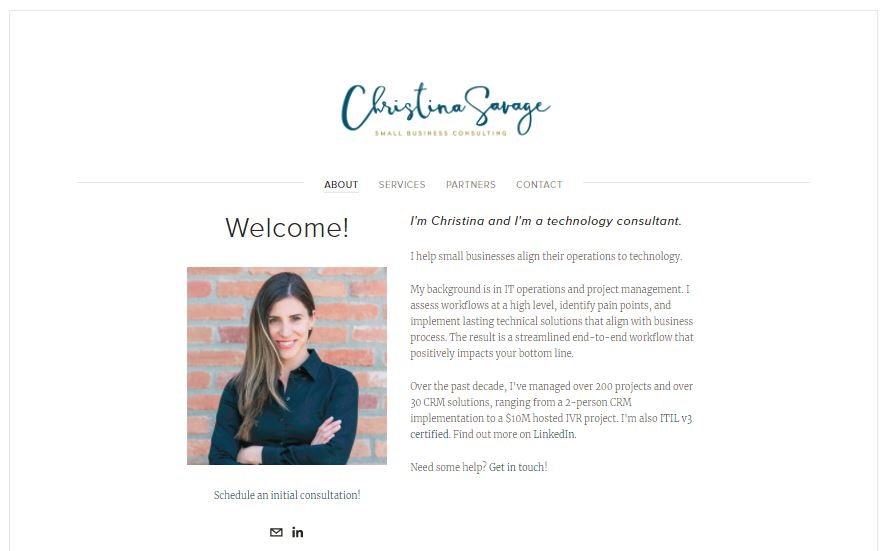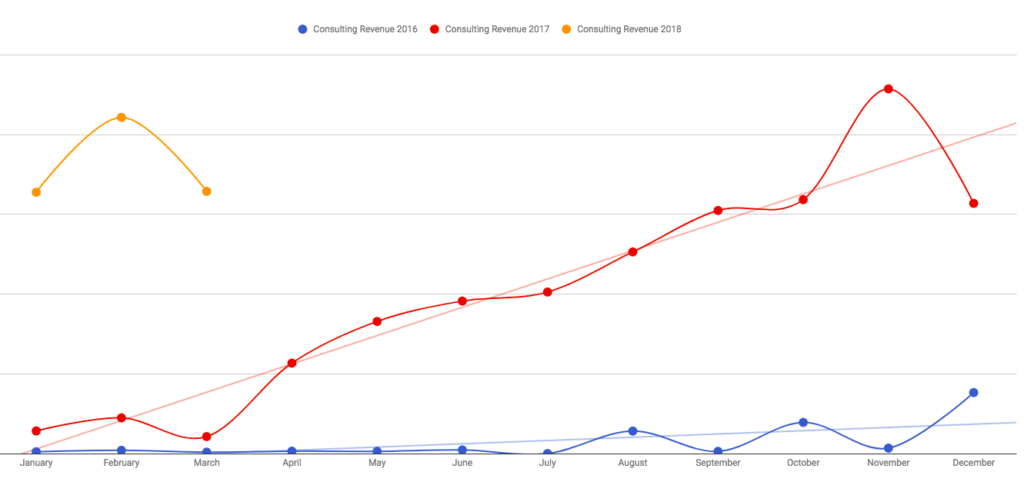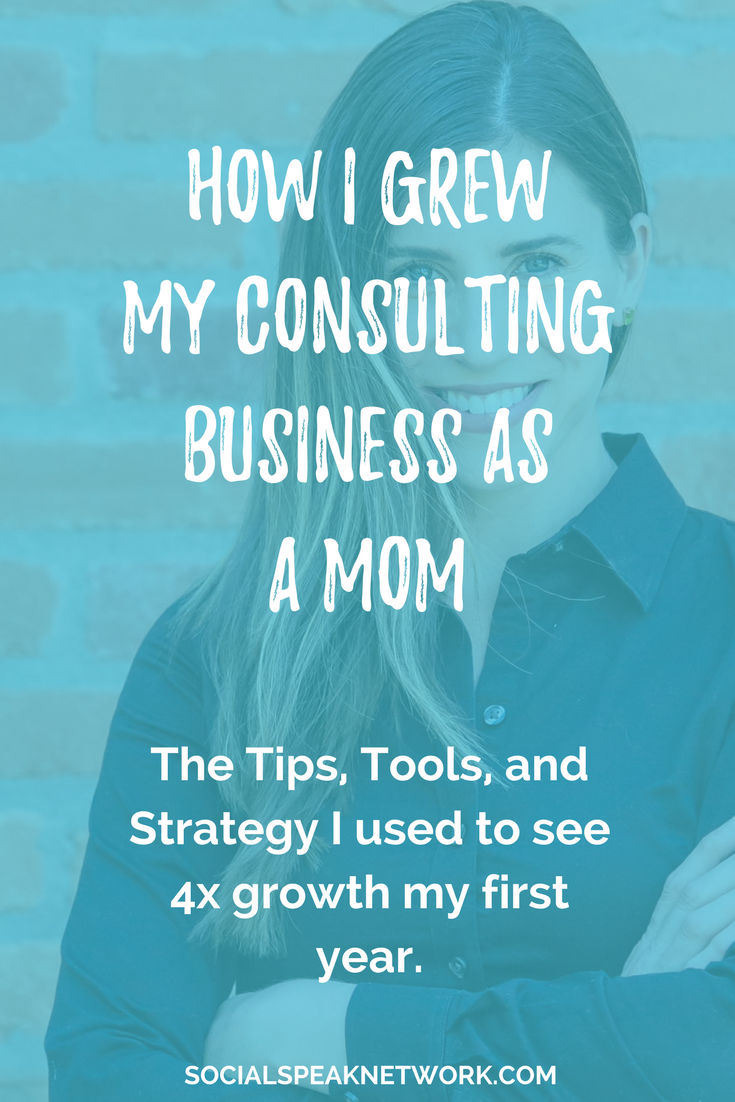By Christina Savage
Owner & Technical Consultant
Christina Savage, LLC
In late summer 2016, I jumped off a metaphorical cliff. I quit my six figure, salaried management job to start my own software consulting business from the ground up.
As a single mom of a 9-year-old son and the sole earner in my household, taking this leap posed a significant risk. Given this fact, you’d think I would’ve created an elaborate business plan, but I didn’t; I just rolled up my sleeves and got started.
But, why?
After years of working in high-pressure software and IT management roles, I was ready for more autonomy and flexibility. I wanted to build something all by myself. Starting a business is, in my mind, a creative process – and I desperately needed to create.
How I got started
In the software world, there’s a saying, “fail fast, fail cheap.” I knew that if I over-thought things, I’d never start. So, I just started getting things done. As an example, I didn’t create a fancy brand; I just used my name as my company name.

Here a few practical steps that will help you start a service-based business:
Buy a domain name
I bought my domain name from GoDaddy, but there are a lot of domain name registrars out there. It’s fast and easy and will typically cost you less than $20.
Name your company and register it with the state
I formed an LLC by registering it with the state, paying the fees, and filling out the required paperwork. Visit your state’s Secretary of State website to find out the process. Depending on your line of work, you may also need a business license.
Set up a mailbox
I bought a P.O. Box at my local post office, but I’ll likely move to a virtual postbox in the future.
Set up a business phone line
I knew that I didn’t want my personal cell phone number posted publicly, so I set up a Google Voice number. It’s free and forwards all calls to my cell phone. If you plan to build a business with more than one person, be sure to look into other VoIP options like Grasshopper or Fluentstream.
Create a logo
I hired my graphic designer friend to create a logo for me. I love it and I have it on everything – my website, my business cards, my invoices—you name it.
Hire a professional photographer
I hired a professional photographer to take headshots and I used them on my website and LinkedIn profile. Professional photography makes a huge difference, especially when you work with people who find you online.
Launch your website
Even though I’m technical and I’ve worked on a lot of websites in the past, I’m not a website designer. I knew that I’d spend too much time banging my head against the wall over my website theme and design if it was too customizable, so I just went the quick and easy route and chose Squarespace. It’s affordable and really easy to use. In the future, I’ll likely move to WordPress because I think it will scale best for me and offer me better SEO, but for now, Squarespace works.

Set up your email
I’ve always been a fan of G Suite because I love the Google platform. I’m a huge proponent of a paid email platform, as opposed to using a personal @gmail.com account. It’s one of the most critical tools in your business. Plus, G Suite makes it easy add and manage users and it offers some of the best collaboration tools on the market. My Google Drive files are well-organized, allowing me to keep my personal and business documents separate, but to also access my documents at any time, from anywhere, and on any device.
Get your financial tools in order
Set up a business bank account. Be sure to keep your expenses separate from your personal expenses. If you decide to move to an S Corp or other type of entity in the future, you’ll need to keep these separate anyway.
It’ll make accounting a lot easier, too.
Set up a cloud-based accounting software. I use FreshBooks and absolutely love it. It’s made for entrepreneurs and small business. It allows me to track my time in real time (I typically charge hourly), quickly generate invoices, and automate payment reminders. It’s also integrated with my bank transactions and credit card gateway. Plus, their support is outstanding. Having FreshBooks allows me to spend only 10 minutes per month on invoicing.
Finally, consider getting business insurance. Many clients may require it.
Start using a CRM
Customer Relationship Management (CRM) software is a central database to track client communication. I consider it the ‘brain’ of my business. Most CRMs integrate with website forms, sales and marketing tools, accounting software, and reporting dashboards. My CRM allows me to track my prospects, organize my projects, build reports, and market to my clients. It’ll also allow me to easily onboard and communicate with future employees.
These initial steps took me about two weeks. It doesn’t take much. Just start!
How I grew (and the emotions that ensued)
Once I set up my systems and processes, I had to figure out how to get clients. I’ve never considered myself a salesperson and I’m not into self-promotion. However, the primary skill that’s contributed most to my career success has been my ability to build and maintain relationships.
I’ve kept in touch with everyone over the years—former coworkers, employers, employees, clients, and vendors. So, when I started my business, I reached out to everyone. I scheduled coffee meetings and a lot of phone calls. This quickly led to a couple of key software partnerships, including my CRM software partner – a referral source that contributed 48 percent of my revenue last year. Other significant projects and clients came from referrals from friends and former clients.
I don’t mean to make this process sound easy. It took a lot of work and even more persistence. There were many days when I literally had no projects. I spent about eight months dipping into savings before my revenue became significant.
I also had a lot of job offers and people trying to get me to come work with them. As someone who’s used to saying ‘yes’ to almost everything, I had to say ‘no’ to a lot of great opportunities and stay focused on my goal of building a business.

What I’ve learned
Once the momentum starts, it keeps going. There will be many days in your journey when you have no idea where your money will come from next month—when your projects wind down and you have few opportunities in the pipeline. It’ll be scary, but you need to keep moving forward. Schedule more coffee meetings, attend a local networking event, reach out to an old colleague, or teach yourself a new skill. If you keep the momentum going, your business will continue to grow.

Structure your day. Even though you may want to sit around in yoga pants all day—and will probably do that most of the time—you need to stay focused. If you work best in the morning, do your most important work before noon. Schedule your meetings, calls, and business development tasks in the afternoon.
Do great work. You have to put your clients first. Make it as easy as possible to work with you. From your contract to the way you accept payment, it needs to be easy. I accept credit card payments from my clients and I wouldn’t dream of passing through the transaction fees. I invoice clients once a month, my time records are clear and detailed, and I give my clients 30 days to pay. Trust is key.
Systematize everything. Even though you may be starting out as a solopreneur, you may bring on employees or consultants in the future. The more clearly-defined systems and documentation you have in place, the easier onboarding and offboarding will be. Even if you just need to hire a consultant, you’ll save yourself so much time and money if they can easily review your documentation and devise solutions for you. Trust me on this.
Say yes. In the beginning you’ll say yes to almost any work that comes your way. As you grow, you’ll need to start learning how to say no and specializing, but the work you do in the beginning will teach you so much. You’ll also get used to facing brand new problems. Every. Single. Day.
You’ll have to tackle projects you’ve never done before. I’m not sure this ever stops. You’ve gotta be confident that you are smart and you’re a problem solver. In the words of Marie Forleo, “everything is ‘figureoutable.’” Don’t shy away from hard things. Focus and figure it out. You’ll get there. I promise.
You’re going to wear #allthehats. I run my business by myself. I’m the business development rep, sales rep, sales engineer, proposal writer, project manager, technical lead, researcher, marketer, visionary, customer service rep, tester, bookkeeper, and accounting department. I even did my own taxes the first year. Because I worked for small, lean businesses for years, I had experience in all of these areas. If you don’t feel comfortable doing these tasks, delegate or outsource them so you can focus on the highest and best use of your time.
Stick to your vision. As I previously mentioned, I received many job offers and invitations to discuss employee-type roles. It’s flattering and sometimes tempting, but I’m proud of what I’ve built—there’s no salary that could pull me away from doing my own thing.
Track your progress. For me, tracking my revenue is an easy metric to monitor. It took me 8 months to start making consistent and sufficient revenue. I gave myself many pep talks and I had to look at my consulting revenue chart every single month to prove to myself that my revenue was trending up. These trends showed me that I actually had a viable business and that I wasn’t blindly following a dream. Supportive friends and family are also key!
Where I am now
More than a year-and-a-half in, I’ve got 28 clients in 12 states and three countries. I’ve provided consulting on CRM, Enterprise Resource Planning (ERP), call center, and help desk software. I’ve written enterprise software manuals and marketing collateral, and I’ve managed a few big projects. And now, I’m starting to narrow my focus to the services I enjoy the most.

I’m starting to consider re-branding and doing some marketing campaigns. To date, I haven’t done any marketing besides partnering with a few software providers.
I also started working with a CPA to reduce my tax liability and I put myself on payroll (yikes!). Finally, I’m focusing on larger, longer-term projects and building a recurring revenue model.
My current areas of focus are intended to help my business grow and reduce the chance that I’ll burn out over time. Next year, I may be focused on completely different objectives. It’s critical to be able to pivot and scale as your business grows.
“A year from now you may wish you had started today” – Karen Lamb
If you’re eager to start your own business, just start with the steps outlined in the “How I got started” section. Take one step forward every day. You may be surprised where you’ll be a year from now. Good luck!
Any questions? Comments? Get in touch! I’d love to hear from you.
Interested in learning more? Take a look at these articles:
5 Social Media Goals To Get You Started




